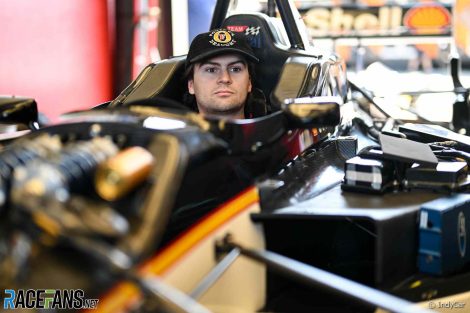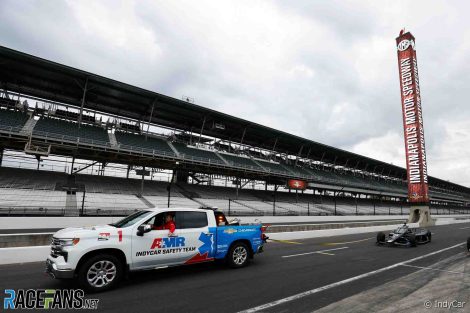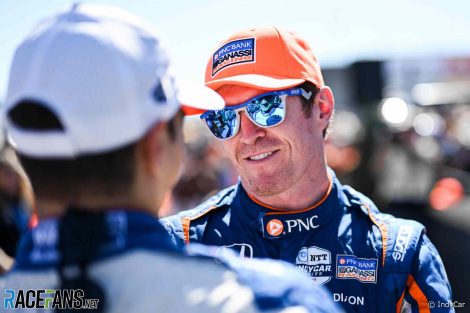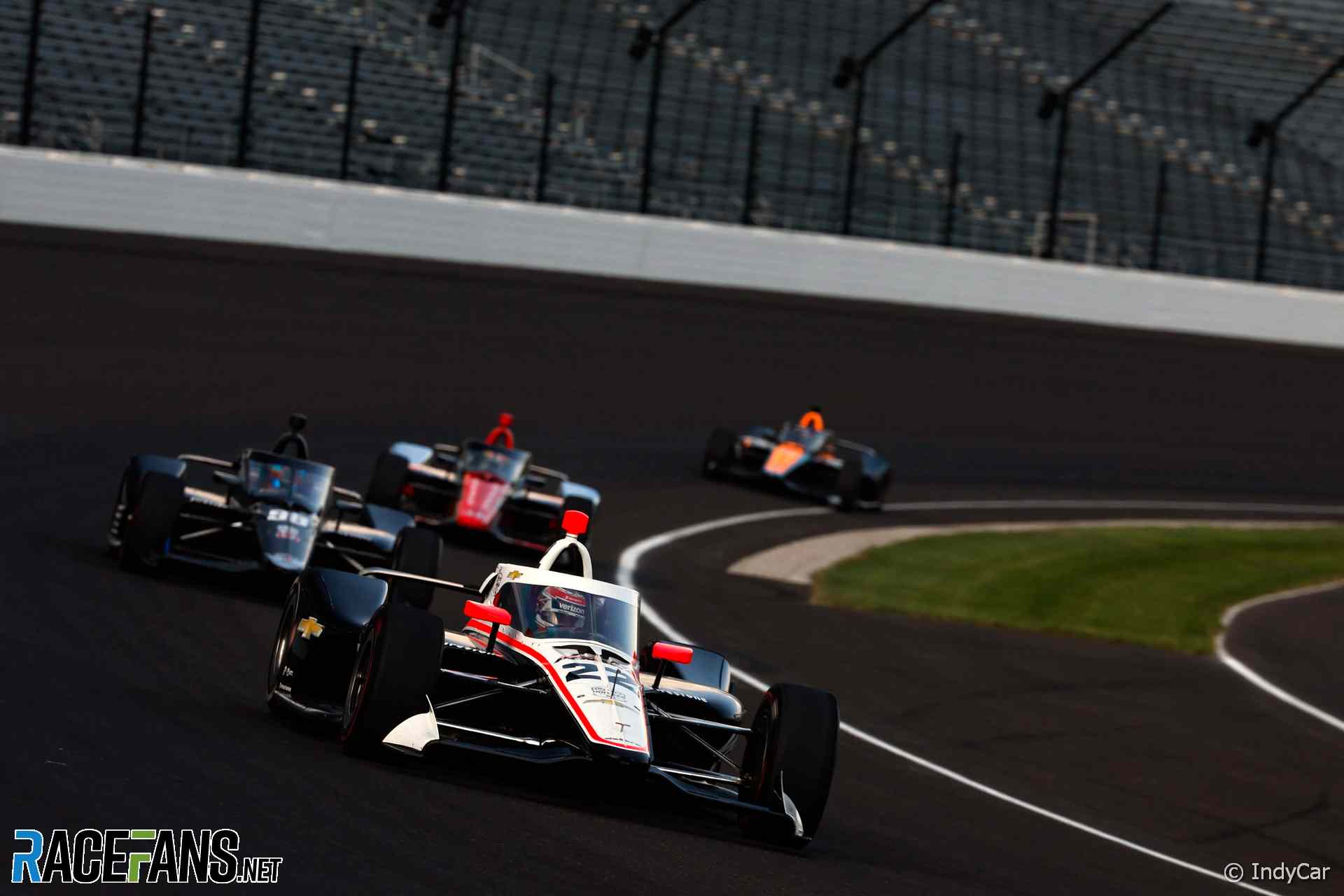A decade since F1 introduced its V6 hybrid turbo power units, IndyCar is due to finally embrace similar technology this year.
Its hybrids were originally planned to arrive in 2022, then were pushed back to 2023 and finally this season. The latest delay was announced last month, committed the series to adding hybrids at some point “during the second half” of 2024, after the Indianapolis 500.With the season beginning on the streets of St Petersburg in mid-March, drivers are weighing up the implications of the championship fight being interrupted by a major mid-season change in their power units, and how that might affect them.
“We’ve got a lot of testing done with the hybrid already, which has been great,” said Andretti’s Colton Herta. “Now that we know that we still have a few more hybrid test days coming up, and some without the hybrid. So it’s probably going to be very crucial for those days to mark down the differences in the two.”

“That could be a season-killer, for sure, if your car is great without it or with it,” said Herta. “You go into the later half of the year, whenever it gets introduced, and your season can be flipped. So you really have to stay on the ball and understand the differences between the two.”
He’s pleased with the progress Andretti’s engine supplier Honda has done to integrate the standard system with its V6 twin-turbo. However he still sees potential for a shift in the competitive balance between engine manufacturers and teams when the hybrids are introduced.
Advert | Become a RaceFans supporter and
“It’s down to engine manufacturer and who implements the new gearbox [best] and how the engine power is transferred and the hybrid part of it is transferred to the powertrain, and how well that is done for drive-ability is going to be a big thing. I think Honda has done a tremendous job with that so far from what I’ve seen.
“But obviously once it’s actually put into play it could be a whole different story because of the timeline and how long down the road it will be. So development is still ongoing and everyone’s kind of making their car better day by day with it.
“For me, it’s really about understanding because this could be a season-wrecker if you go to the hybrid and you don’t understand what it can do to the race car and all of a sudden when you have a top car, every weekend you might fall back to seventh, eighth, ninth place, which could be a season-killer for you. So really understanding the different dynamics of it is going to be the most important part for, I think, every team this year.”
No date has been set for the introduction of the hybrids and the compact nature of IndyCar’s calendar may make it a challenge. It races on consecutive weekends after the Indy 500, then has fortnight gaps between its rounds in Road America, Laguna Seca and Mid-Ohio.
That is followed by four races over three consecutive weekends, including the Iowa double-header, which may prove to tight for time to introduce the hybrids. Past that there is a two-week gap before the final five races begin, beyond which point it may no longer be considered worthwhile to change engine formats before the next season.
Will Power, who has been testing Chevrolet’s implementation of the hybrids, expects it will make a significant difference to how the car handles.
Advert | Become a RaceFans supporter and
“There’s no question that it’s going to be a factor in the championship,” he said. “Obviously the weight distribution changes, the weight of the car goes up. You have this hybrid system that you have to use as efficiently as possible.

He also suspects one important factor will be whether the hybrid ultimately “complements” one manufacturer’s engine more than the other: “Is it the Chevy or the Honda? Because it’s going to hit in a certain power range.”
Adding the hybrid systems will significantly increase the weight of the cars. Dallara has worked on lightening its DW12 chassis to mitigate that effect.
As a result, drivers will have a more nimble machine over the opening races before the hybrids arrive. Once they do, although their cars will become heavier, it will give them more power to play with.
“Obviously on a track with long straights and all that, you’re going to get benefit from the horsepower,” said Power. I think there’s a lot of potential in that hybrid.
Advert | Become a RaceFans supporter and
“I reckon it’ll be started pretty conservatively, so if the lap times happen to be slower, that’s the reason. But eventually they’ll be faster. You want to ease into it. I don’t think you just want to go, ‘this thing will give 150 horsepower, bang, let’s go do it’.
“It’s still a hit. It really jumps out of the corner when you’re using the hybrid. And you’re only using a third of what it’s capable of.”
Although the car will handle differently with the hybrid, little has changed at the wheel for the drivers. “It’s hardly changed anything,” said Power. “The car pretty much behaves the same and they’ve given you the ability just to push a button out of a corner and that’s it. It’s auto-regen[erating], so you’re not holding a paddle or anything like that. It’s pretty straightforward.
“It’ll be more about extracting the most out of the system, where you deploy it, all those strategies. It’s up to the teams to do the simulations and understand where to do that and where to regen, all that sort of stuff.”
Another potential scenario any championship contenders will be fearful of when the hybrids are introduced is the risk of reliability problems. However the reason for IndyCar’s delay in introducing the units has more to do with concerns over parts shortages than reliability.
“I’ve done quite a few test days where you just run all day, two days and no problems,” said Power. “No problems at all. I think [the delay is] a bit of everything, a little bit of supply issue and so on.
Advert | Become a RaceFans supporter and
“I think IndyCar wants it to be absolutely bulletproof when it’s introduced, so I think they made the right decision there.

Despite the complications arising from the arrival of the hybrids IndyCar’s most successful active driver, six-times champion Scott Dixon, supports the series’ decision to make the change.
“It’s important for the future of the series. I think when you’re a driver especially and when you’re so close to it and hands on with it, you want everything to happen as quick as possible, but that’s just not reality. But I think we’re in a really positive spot right now.
“The process has been to make it as reliable as possible or to make it really roll out in a smooth way.”
Dixon knows how close IndyCar title fights can be and how previous every point is. He took his last title by just 16 points in a series where a win is worth 50, and his 2015 title came in a points tie with Juan Pablo Montoya, Dixon prevailing on countback.
Advert | Become a RaceFans supporter and
He is therefore sensitive to the potential for reliability problems. “At the moment in testing, when it fails, you have to stop the car immediately. I don’t know if that’s going to be true when, say you’re leading a race by 20 seconds and you’ve got three laps to go, I don’t think any driver of a team is going to stop the car.
“Whatever happens in that case, there’s a lot of unknowns, at least for me. I’m sure other people know about it.
“I think it is what it is right now. I think it’s definitely a positive that they’re not just abandoning it. I think you’ve got to do it properly in the way that they’ve done it, and I think the technology is going to be huge. It’s a pretty tricky system and something that will hopefully evolve pretty quickly.
“I’m excited for that part of it. You’ve just got to roll with it. For me, I just want a car that’s fast, and whatever which way you have to drive it. But this will definitely add some pretty tricky driver situations in how you use it and something that if you use well I think can definitely benefit you. I’m excited for that side.”
IndyCar
- McLaughlin denies Power pole position to lead Penske one-two in Barber
- Newgarden admits he “failed my team miserably” over disqualification
- Ghiotto gets 11th hour call-up for IndyCar debut at Barber
- McLaughlin and Power accept penalties over misuse of push-to-pass system
- Pourchaire sure he’ll get more chances to join F1 after strong IndyCar debut





MacLeod (@macleod)
29th January 2024, 7:44
I wonder how much Honda is here in the advantage as they already has a system who works very good.
BasCB (@bascb)
29th January 2024, 10:45
Do they really have that?
MacLeod (@macleod)
29th January 2024, 13:56
@bascb – Compaired with Chevolet yes as they has working several years on performance hydride systems.
@asd – Yes they have several systems but not on high performance racing engines/systems they have almost none experience.
anon
29th January 2024, 18:16
@macleod there still isn’t any real advantage for Honda.
Firstly, and most importantly, all of the mechanical components are being supplied as a standardised unit by Mahle – partially for cost controls, but partially also because of limitations on the size of the hybrid unit that can be installed without having to redesign the chassis.
Secondly, as others noted, because it is a standardised unit, there is a tripartite working group between Honda, Chevrolet and the governing body, with both manufacturers carrying out joint test sessions to help Mahle develop the new hybrid systems.
Thirdly, even excluding the standardised hardware and partnership arrangements through the governing body, there is also the fact that Honda’s North American division has traditionally been semi-autonomous from the main parent body of Honda and has usually not had much, if any, overlap in their motorsport projects.
MacLeod (@macleod)
30th January 2024, 7:50
Then i stand corrected as I thought those systems were non standard. Maybe they can give Honda F1 a tip (super capacitors could be handy for F1)
Asd
29th January 2024, 11:19
Chevrolet has working hybrid systems too.
Chevrolet produces hybrid cars and EVs, it is as highly advanced in this technology as Honda.
MichaelN
29th January 2024, 16:34
Indycar does not have meaningful competition even on the engine front, indeed, Honda and Chevrolet have been working together with Indycar to make this hybrid PU.
It’s not a very complex system; there is no MGU-H or anything like that. It’s something both Honda and Chevrolet can combine with their rather basic Indycar engine without issues.
greasemonkey
29th January 2024, 18:23
GM (via Cadillac) just did pretty well over 24 hours of Daytona on a hybrid system a lot more like Indy will have than F1 has.
BasCB (@bascb)
29th January 2024, 10:45
I am somewhat baffled by the idea of throwing this huge change into the middle of the season, since yeah, it is going to be a major turning of the table for the championship.
Abies de Wet
29th January 2024, 11:20
I Hate This Battery Nonsense !!!!!!!!!!!!!!
Don
29th January 2024, 15:43
Well, have no fear because IndyCar’s system is unique and doesn’t use a battery. It uses a Super Capacitor and motor, both fitted in the bellhousing which makes packaging challenging. Very different than F1’s hybrid.
Radoye
29th January 2024, 20:58
Actually, no batteries involved in IndyCar’s hybrid solution – they are using supercapacitors instead…
kuvemar
29th January 2024, 23:15
Well, I have some bad news for you …
Coventry Climax
29th January 2024, 13:42
There was an article on the delay of the hybrid introduction on december 7th, ’23, as well as another one shortly after.
I then commented I thought it was a weird choice, as it would likely upset the weight distribution of the cars midseason.
Lo and behold, the coin finally dropped, apparently.
I still think it’s a stupid decision to go hybrid in the first place, apart from thinking it a stupid decision to do it midseason.
They run on alcohol, which is easily made sustainably, and if it’s sutainable, why bother about saving a bit of that yet make the cars significantly more complicated, way more heavy and hence more unsuitable to race?
But they took weight off, of the chassis, I hear you say.
Like I commented on the first article: If that’s so, they could have saved that weight much earlier already, and have even better -and more efficient- racing cars.
Christopher Rehn (@chrischrill)
29th January 2024, 13:56
If they cannot introduce it to the season start, surely it should be pushed back to next season? Introducing such a massive change “some time” during the season opens up a can of worms. What if a Penske driver is leading the championship with the old engines, will they delay the introduction? What if it’s the opposite and they rush it to give themselves a new chance? I say wait until 2025.
PeterG
29th January 2024, 14:28
I remember in 2004 when they wanted to slow the cars down by going from 3.5ltr to 3.0ltr V8’s but made the call so late none of the manufacturer’s were ready so they ended up starting the year with the 3.5ltr engines & making the switch to the new 3.5Ltr engines starting from Indy.
And while not the same thing due to been voluntary rather than mandated in the more open CART era it wasn’t uncommon for teams to bring new chassis & completely different engine specs mid-season. Was even occasions where teams would switch engine suppliers mid-season or run different chassis and/or engines depending on circuit configuration. For example maybe running a March chassis on the road circuits & a Lola on the ovals or something.
But of course you can’t do that now because everything is sadly overly restrictive & single make. Was more fun when it was more open.
Fer no.65 (@fer-no65)
29th January 2024, 14:31
Makes no sense whatsoever to change something like this mid season. They probably want to show that they are “getting on with the times”, but doing so halfway through a championship is daft.
Dex
29th January 2024, 15:53
All they show is lack of professionalism of the series, compared to most major sports and motorsports.
The Dolphins
29th January 2024, 15:11
We can complain about what a joke the FIA and/or F1 can be at times but they cannot hold a candle to IndyCar.
MichaelN
29th January 2024, 16:38
Indycar certainly does some goofy things, but it’s important to keep in mind that this is quite a low-budget series in the grand scheme of things. Red Bull alone probably spends more on its four F1 cars than all the Indycar teams combined.
The Dolphins
29th January 2024, 17:19
This is not a question of budget, however, this is simply poor governance.
Fer no.65 (@fer-no65)
29th January 2024, 21:30
And they have an easier job given it’s just a local series, not an international affair.
grat
30th January 2024, 7:35
In general I think IndyCar does a much better job of handling a racing series than F1. The stewarding is more consistent, and they’re willing to change a bad rule. They’re not nearly as committee-bound or politically managed as F1.
Yellow Baron
31st January 2024, 0:23
I was going to say the same thing. I’m so glad for indycar because it’s a much more no nonsense get on with it series which has a little old school vibe to it. To the point I’d almost rather watch a 2023 indycar season over a 2021 F1 season. Just because F1 is so full of nonsense nowadays.
My only wish, as with all series, is that they lower the commentary volume relative to the car sounds. Does anyone remember when commentary was commentary and not just a constant stream of words for the sake of saying something?
Also very important point at the end, these things tend to cause a lot of constipation.
DaveW (@dmw)
29th January 2024, 23:29
Isn’t regen going to be pretty useless on an oval? It will just be a lot of weight.
baasbas
30th January 2024, 0:20
Why assume it is incompetence to introduce it half way through a season? It could well be deliberate. Some controversy, a championship leader losing his points lead, changing fortunes.. Sounds like something Netflix could come up with..